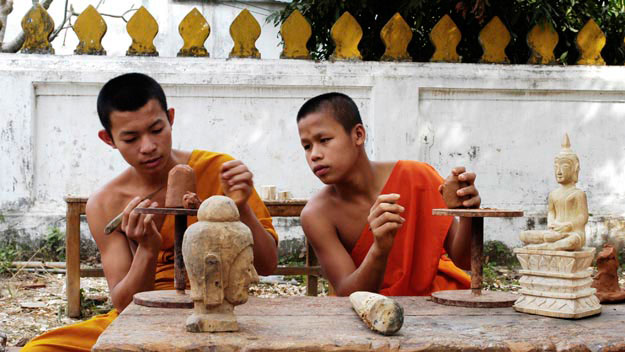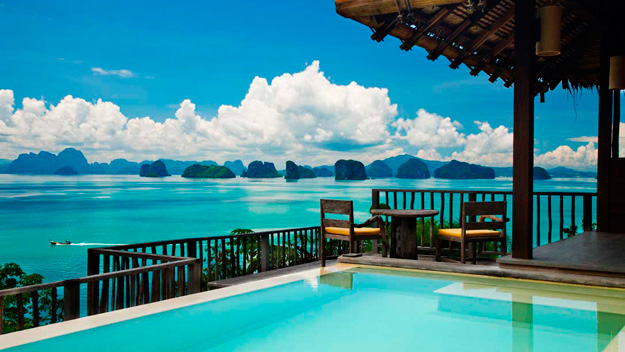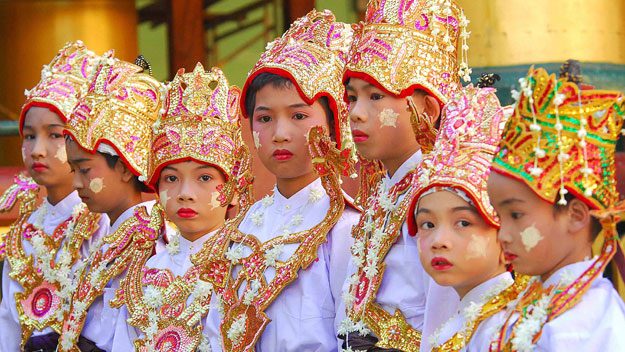Twenty years ago Luang Prabang was a forgotten city: an old royal capital that had fallen from grace. Shunned by the country’s new communist regime, it languished in the jungle until a trickle of intrepid travellers stumbled upon it: Indochina’s last medieval city, a sacred site of 66 Buddhist temples and ramshackled monasteries, perched on a promontory high above the mighty Mekong River.
Word soon spread that Laos harboured a jewel: a city of golden spires that shimmered under the sun; a city as enchanting as any in an ancient fable that once had held sway over a kingdom known as the “Land of a Million Elephants and the White Parasol”.
Colonised by the French in the mid-19th century, this charming backwater was desperately in need of a makeover. Its traditional teak houses were sagging, its baroque villas peeling and its 800-year-old temples falling down. Then in 1995, UNESCO came to the rescue, adding the city to its World Heritage list.
Restoration began in earnest and, as millions of dollars poured in, the city’s pulse quickened with the advent of tourism.
No one can deny this once sleepy place is busier than it ever was. An international airport has been built — thankfully out of sight — and a new commercial centre has sprung up at the end of the runway. Yet, essentially, the old town – the heart of the ancient temple city – remains unchanged.
Here, the rhythm of daily life still runs around the routine of its monasteries. Every morning before dawn, the monks leave their lodgings to collect alms from devotees. Carrying bowls and led by their abbot, they file along the streets collecting freshly prepared food.
During the day, elders and novices, clad in orange and saffron robes, stroll along the streets, umbrellas held aloft to protect their shaved heads from the sun. Then, before dusk, they return to their temples and, as the light begins to fail, the streets fill with their chants and softly beating drums.
The quietest part of the old town is around Wat Xieng Thong. Built in the 12th century, this temple has gilded spires and teak walls, decorated with intricate carvings and delicate mosaics, and a roof of orange tiles that sweeps down almost to the ground. In the candle-lit interior is a larger-than-life golden Buddha, often wreathed in incense.
Even though the temple has become a major tourist attraction, the surrounding area is so quiet that a ping of a bicycle bell is often the loudest sound on the street.
In fact, at the nearby Auberge Le Calao, a charming little inn overlooking the Mekong, you can often pick the time of day by a succession of sounds.
In the morning around nine, a ting-a-ling-ling heralds the arrival of a vendor selling limes, lemons and sugar cane — the merchandise neatly displayed in a glass box fixed above the front wheel of his vintage tricycle.
Ten minutes later, there’s the gentle hooting of the bread seller’s horn – his crusty baguettes, oven fresh. Then the plaintive whooping of an old crone, selling sun-dried toads on bamboo skewers, greets guests as they breakfast on the auberge’s riverside terrace.
Around three in the afternoon, at the end of siesta, the ping-ping-ping of a bicycle bell announces the ice-cream seller, his home-made ices, irresistible to local kids during this, the hottest part of the day. Down on the Mekong, the loudest sounds are either the putt-putt of a two-stroke engine or the splash of an oar.
During the cool dry season (December to March), as the water levels fall, local gardeners plant their greens on the exposed river banks. Nearby, commuters from outlying villages buy snacks at food stalls before catching dugouts or motorised longboats across the river from one of the rickety wharfs.
Much of the produce from the river gardens is sold to the city’s new restaurants, elegantly housed in 19th century French colonial villas on the city’s main boulevards. Thanks to the French, the food is fabulous and, thanks to the exchange rate, you can eat like a prince on a pauper’s purse. In the morning ,the smell of freshly ground coffee and warm baguettes fills the streets.
On Sakkarine St, the Cafe Ban Wat Sene serves superb cup of coffee ($1.70), continental or cooked American breakfast ($2.50 and $4 respectively). Its patisseries, especially the lemon tart and banana cake ($2.50 each), make an afternoon tea stop essential.
Around the corner is The Apsara — a chic boutique hotel on the Nam Khan River, a tributary of the Mekong — where you will discover one of the best dinners in town. For starters, try the Western-style fish cakes with lemongrass on a tomato and basil reduction ($6), followed by a tangine of goat kid, with almond couscous, green salad and orange segments ($9).
A six-minute walk away is L’Elephant. Here, you can indulge with a $6 tomato and buffalo mozzarella salad (the mozzarella is from Chang Mai, Thailand, two hours away by light plane), followed by medallions of buffalo in a green peppercorn sauce, rice and vegetables ($8). L’Elephant also serves a superb Lao food tasting menu.
Opposite the Royal Palace is another gem — the Blue Lagoon. Run by a charming woman from Normandy, France, it serves the best Mekong River fish in town, often in a Dijon mustard sauce ($7).
Those visitors on a diet should walk around the bustling early morning food market, outside the Royal Palace’s eastern gate. Here, they will find every Lao delicacy, including plump little bats, barbecued frogs and sun-dried toads, a condiment of shredded buffalo skin, ugly whiskered catfish, slimy black eels, monkey’s gizzards and the bleeding snouts of wild boar. Not tempted by the local cuisine? Then, take another walk around the Royal Palace — a fascinating fusion of French colonial and traditional Lao architecture, surrounded by a frangipani-scented garden.
Once known as the “navel of heaven and earth” (before the communists overthrew the god king Sisavong Vattana and starved the royal family to death in a remote cave), it still displays possessions of the late king and queen, including their bed, hair brushes and family portraits.
There is also a cabinet of gifts from other heads of state, including a moon rock and model of Appolo 11, thoughtful gifts from US President Richard Nixon, whose administration was, at the time (the Vietnam War), turning Laos into one of the most heavily bombed places on earth.
If you leave this mausoleum feeling a little blue, cross the street and climb Phousi Hill. Crowned with a little temple, it has a beautiful view of the Mekong River and surrounding mountains. Late in the afternoon, the smell of wood smoke and sizzling chicken rises from the glowing embers of little clay barbecue ovens, tended by children, on the city’s pavements.
Every mother, it seems, comes onto the street to wash her greens in bottled water, before getting down to the serious business of sharing dinner, picnic-style, with her children.
Before you join in (and you will be welcome), ask a boatman to take you for a trip on the Mekong during the magic hour before dusk. It’ll cost less than $5 and the view you get of the setting sun, as it turns the river from cafe latte to gold, is worth every cent.
Then, just before turning in, pay another visit to Wat Xieng Thong, especially if the moon is full. Walk around its paved grounds, where paper lanterns and fireflies light the way. Here, all is well with the world – the surroundings serene, the peace palpable — a little slice of Shangri-la.
TRAVEL TIPS:
In the cool, dry months from November to March, take a fleece and other pieces of warm clothing. For the day, take shorts and T-shirts.
Visas are US$30: apply with two passport photos on arrival at airport. Payment must be made in US$.
Local currency: 8426Lak = AUD$1.
Laos is an inexpensive country. It’s possible to take humble clean lodgings and eat three local meals a day on a budget of $20 a day. It’s also possible to live like a king on $60 a day.
The Bamboo Curtainby Christopher Kremmer (HarperCollins, $29.95) investigates the disappearance of the Lao royal family and provides a fascinating perspective on 20th century Laotian history.Laotian Travel Guide is a useful first-stop website to learn more about the country and research places to stay and eat. Visas and information is the website address to visit for a visa. Thai Airways has more than 30 flights a week from Australia to Bangkok. Bangkok Airways flies twice daily to Luang Prabang. Intrepid Travel, Travel Indochina, World Expeditions and Peregrine Adventures have tours to Laos and Luang Prabang.
Laotian Travel Guide is a useful first-stop website to learn more about the country and research places to stay and eat. Visas and information is the website address to visit for a visa. Thai Airways has more than 30 flights a week from Australia to Bangkok. Bangkok Airways flies twice daily to Luang Prabang. Intrepid Travel, Travel Indochina, World Expeditions and Peregrine Adventures have tours to Laos and Luang Prabang.



